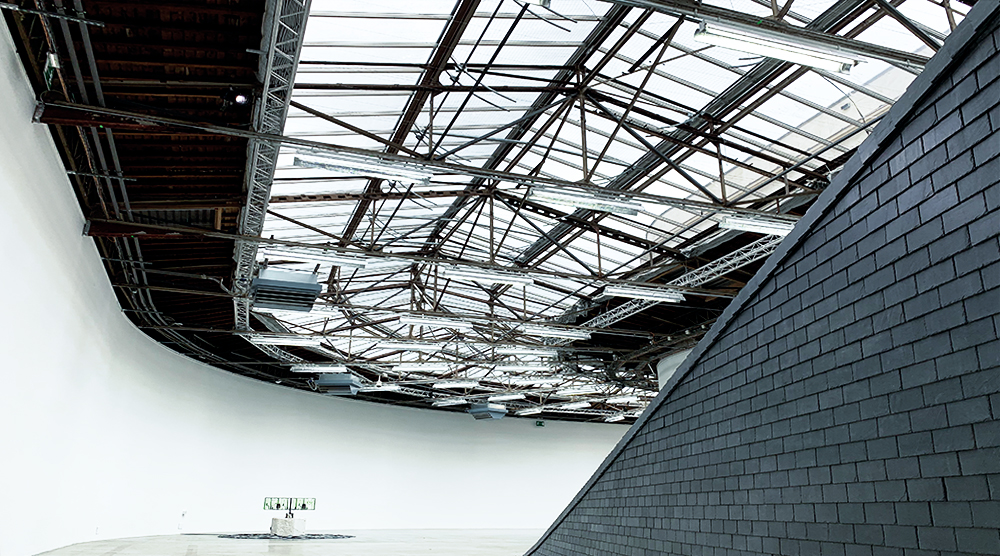Victor Vasarely, Centre Pompidou – Vik Muniz, Maison Ruinart – Theaster Gates, Palais de Tokyo – Jean-Michel Othoniel, Galerie Perrotin
Taking the last glimpse of freedom of our united Europe before the grand departure of Britain, (if ever), I went to Paris for precisely 30 hours to visit a handful of exhibitions everyone is talking about. A homage to Op Art and Vasarely at Centre Pompidou, a mysterious journey to “Agora” of Jean-Michel Othoniel at Galerie Perrotin and gathering around environmental issues, as a common denominator with “Shared Roots” of Vik Muniz by Maison Ruinart and “Amalgam” of Theaster Gates at Palais de Tokyo.
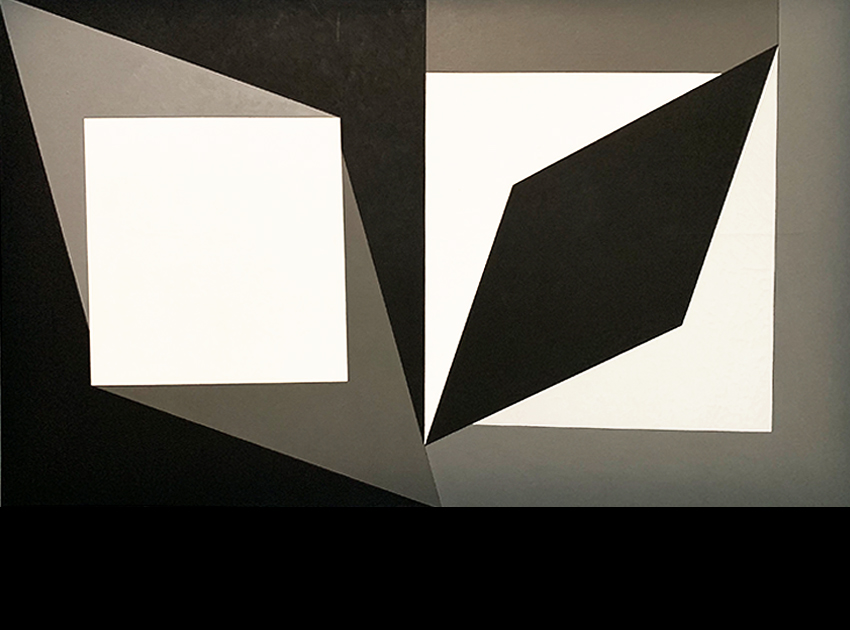
“Vasarely.Sharing Forms” by Victor Vasarely / Photo © Courtesy of ZOLTAN+
CENTRE POMPIDOU X VASARELY
The Centre Pompidou presented the first major retrospective of Victor Vasarely, 55 years since his work was last exhibited. It is time for the new generation to discover Vasarely’s work and his extraordinarily prolific output outside of the art scene.
Through 300 works, paintings, studies of drawings, design objects, publications, architectural projects, sculptures and advertisements, the exhibition explores the world of Vasarely and showcases all the facets of the creation of the father of Op Art. The exhibition follows a chronological and thematic path from his artistic training in the wake of the Bauhaus movement to his final experiments inspired by science fiction, via his universal visual language and the ambition of art as a form of social mass media.
Victor Vasarely, born Győző Vásárhelyi in Hungary, in 1906, and moved to Paris in 1930, where he worked as a graphic designer in advertising before devoting himself fully to art after the war. His abstract style, based on the observation of reality, would rapidly start
to integrate the quirks and disorders of vision. In the mid-1950s, he laid the foundations
for what would become known, a decade later, as Op Art. A key moment in the history of abstraction, optical-kinetic art, based on a strictly scientific process in which paint became an art of time as much as an art of space. Vasarely’s work was fully rooted in the scientific, economic and social context of the 1960s and 1970s.
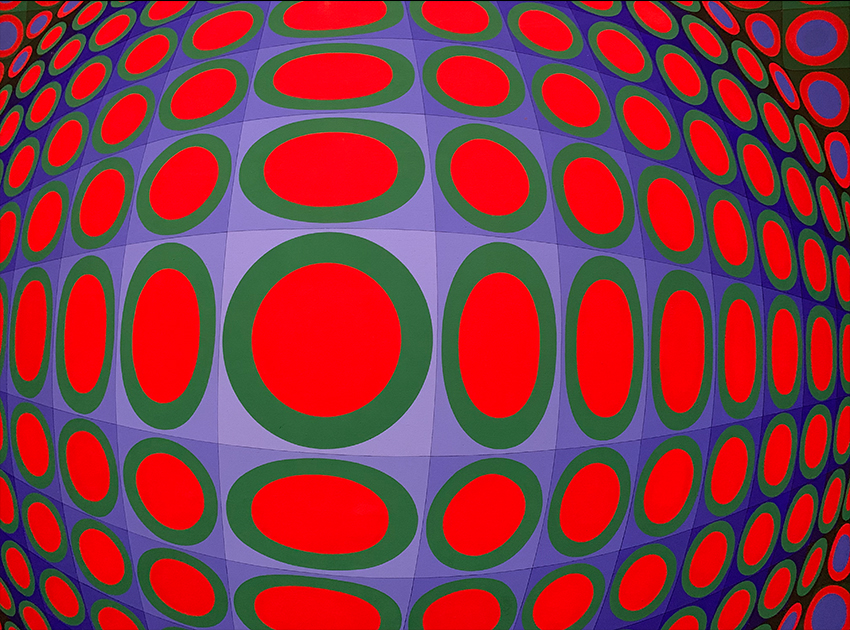
“Vasarely.Sharing Forms” by Victor Vasarely / Photo © Courtesy of ZOLTAN+
Having trained at Mühely (Workshop) in Budapest under Sándor Bortnyik, a former Bauhaus student, Vasarely learned to adapt the language of modernism to commercial communication. After moving to Paris his “Zebra” series begun to foreshadow the waves and vibrations of the kinetic period. Abandoning the literal use of form, Vasarely used various illusionistic processes to highlight the pitfalls of vision and the ongoing metamorphosis of the world.
It was during the war years, that Vasarely’s artistic ambition truly asserted itself. Behind the three great cycles around which his work developed on the verge of the 1950s, we can discern the structures underlying the real world, perceived in its great cycles as well as in its most derisory manifestations.
“Crystal-Gordes” with its complex optical effects, becomes the model for his painting in order to reflect the disturbance and strangeness of vision. “Photographismes” and “Naissances” marked the reduction of Vasarely’s language to black & white in the early 1950s. The reversibility of positive and negative photographic images is one of the sources of this development. In addition, the contrasts between black & white generated optical phenomena that determined a dynamic perception and oriented the creative process toward programming.
His painting vibrates, flickers, scintillates in such a way that it cannot be perceived immediately in a flash, but through time. Vasarely was inventing what the next decade would call Op Art, one of the most significant developments of geometrical abstraction.
He developed a “plastic alphabet” in the early 1960s, consisting of a lexicon of six simple geometrical forms embedded in squares of pure colour. Permutations of geometric forms are cut out of a coloured square and rearranged. He worked with a strictly defined palette of colours and forms (three reds, three greens, three blues, two violets, two yellows, black, white, gray; three circles, two squares, two rhomboids, two long rectangles, one triangle, two dissected circles, six ellipses), which he later enlarged and numbered.
As of 1965, each of the six pure colours of the plastic alphabet generated 12 to 15 intermediary chromatic values and the new colour chart introduced particularly refined shading effects into the contrasted and flickering mosaic of the works generated from the first alphabet. In order to master the very many combinatory possibilities Vasarely included them in a systematic and computerizable set of permutations and progressions and this pre-digital abstraction thus revealed its profound complicity with cybernetic thinking.
“Complexity thus becomes simplicity. Creation is now programmable” Victor Vasarely
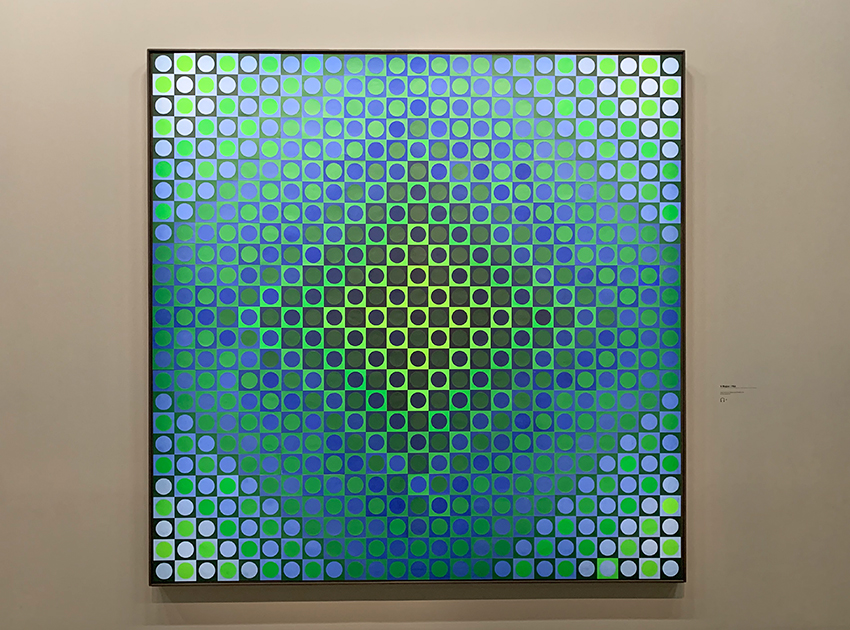
“Vasarely.Sharing Forms” by Victor Vasarely / Photo © Courtesy of ZOLTAN+
Having defined a vocabulary capable of undergoing various adaptations and declensions with the plastic alphabet, Vasarely worked to disseminate his forms as widely as possible. Screen-prints, sculptures and posters testify to Vasarely’s desire to expand art beyond the institutional milieu. His immense popular success in the 1960s and 1970s no doubt surpassed his own hopes. His work was on display everywhere: in design and decoration, in fashion and shop windows, on book covers and magazines, record sleeves, in films, television and large-scale billboards all over the city. It was a rare example of society taking ownership of an artist’s language.
“I am not in favor of private possession of creations. I don’t care if my work is reproduced on kilometers of cloth. We have to create a multipliable art.” Victor Vasarely
In 1954 the construction of the Caracas university campus offered Vasarely his first opportunity to give concrete expression to his ideas on how to integrate art into the city, alongside Jean Arp, Alexander Calder and Fernand Léger.
For Vasarely, buildings had truly become the place where he shared his forms, rather than museum walls. The most significant ones appeared during the 1970s: in the new building at Montparnasse station in Paris, in the headquarters of Renault in Boulogne-Billancourt, on the façade of RTL radio station and in the dining room of the Deutsche Bundesbank in Frankfurt.
In 1972, recreating the logo for Renault was one of the most important collaborations between Vasarely and Renault that the artist undertook with his son Yvaral and the logo was in use until 1992.
His poetic-scientific imagination is revealed in titles where words encountered at random in geography atlases are replaced by references to “signals of worlds”, “metagalaxies”, “interstellar landscapes”, the “sound of quasars” and the “beating of pulsars”.
“Carried by the waves, I let myself be swept forward now toward the atom, toward the galaxies, passing through attracting and repelling fields”. Victor Vasarely
However, it was in the Foundation bearing his name in Aix-en-Provence that Vasarely gave concrete expression to one of his most audacious projects. In 1976, Foundation Vasarely was inaugurated by French President Georges Pompidou. The same year his kinematic object was installed in Paris and with a large donation of works in the Vasarely Muzeum located at his birthplace in Pécs, Hungary.
In 1987, the second Hungarian Vasarely Muzeum was established in Zichy Palace in Budapest with more than 400 works. Vasarely died in March 1997 in Paris, at age 90.
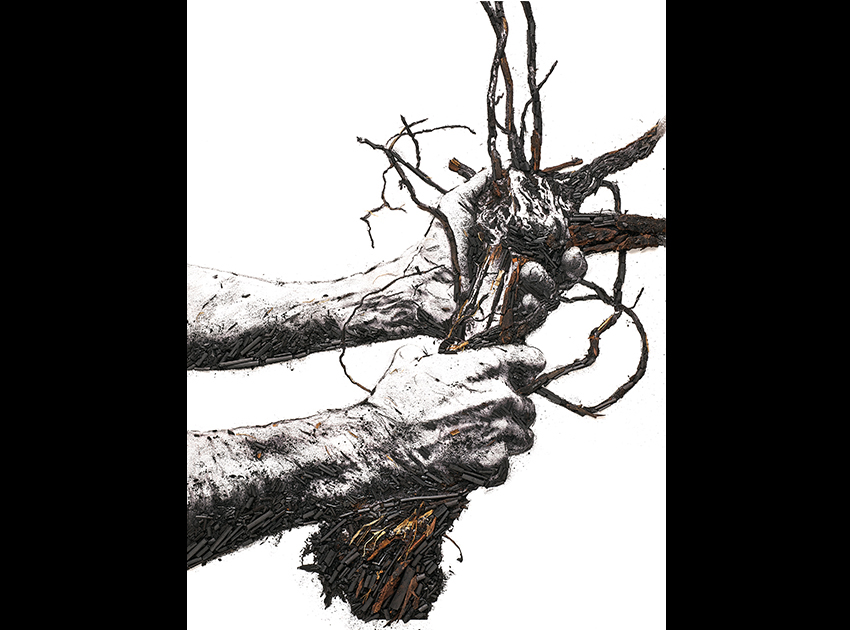
“Flow Hands” of the series of “Shared Roots” with the hands of Frédéric Panaïotis by Vik Muniz / Photo © Courtesy of Maison Ruinart
VIK MUNIZ X RUINART
“Shared Roots” … an ode to the creative powers of nature and mankind.
Hidden in the 2nd district at the Palais Brongniart, the 19th-century former stock exchange, the Brazilian artist, photographer Vik Muniz presented his latest photographic works in collaboration with the champagne house Ruinart.
Muniz initially was a sculptor and through the photographic representation of his work he grew to photography. Muniz perfectly incorporates everyday objects, cars, ashes, dust, chocolate, garbage dumps and diamonds to create bold, large-scale imagery, deriving from pop culture and art history. Muniz often gets his inspiration from postmodernists and admits that he does not believe in originals, rather in individuality. He often destroys the originals of his work and only the photo remains. Muniz’s distinctive practice explores the instability that exists between craft and reproduction, between art and popular culture.
“When I take a photograph, I intuitively search for a vantage point that would make the image identical to the ones in my head before I would make the picture”. Vik Muniz
In 2008, he undertook a project in Brazil, photographing the “catadores”, the trash-pickers, as figures from emblematic paintings, such as Jacques-Louis David’s Neoclassical “Death of Marat”, then in 2010 documented it in the film “Waste Land”.
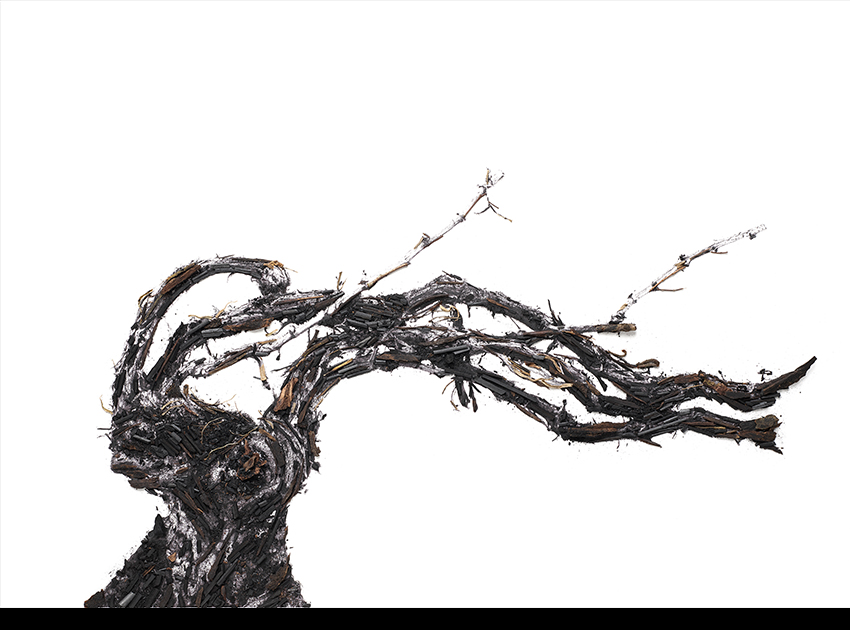
“Flow Diptych – Part II.” of the series of “Shared Roots” by Vik Muniz / Photo © Courtesy of Maison Ruinart
The Maison Ruinart, founded in 1729, has a long commitment to art by commissioning artists since 1896 when they created their first artwork by Czech artist Alphonse Mucha, in a context where French philosophy and culture had great influence, shining like a beacon.
Each year Maison Ruinart commissions the world’s finest contemporary artists, giving them carte blanche, offering them a residency in Reims to pay tribute to their heritage. In 2019, the Brazilian Vik Muniz was chosen to deliver his vision of the terroir. His collaboration started with his artist residency in Reims. To create his series, following the harvest in 2018, he spent countless hours at Sillery, the long-standing vineyard of Maison Ruinart.
To launch the exhibition Muniz set up a large-scale, mirrored video installation with a time-lapse film giving an insight into the creative project. A giant ampelographic image of a plant composed of hundreds of leaves and branches from the Sillery vineyard. In addition, a young dancer of the Étoile du Ballet de Opéra National de Paris, Germain Louvet was invited to perform.
The impressive and complex series of Muniz is exceptional; it is set out to capture the relationship between humans and nature. Muniz created a series of work inspired by the idea of flow, based on large pieces of blackened wood and charcoal. He also brought new life to leaves of an emblematic grape mixed with other natural elements. The picture “Flow Hands” was featuring the actual hands of the cellar master of Ruinart, Frédéric Panaïotis.
Muniz says, he believes that “the more difficult the path, the better the result”. He defines himself as an “illusionist”.
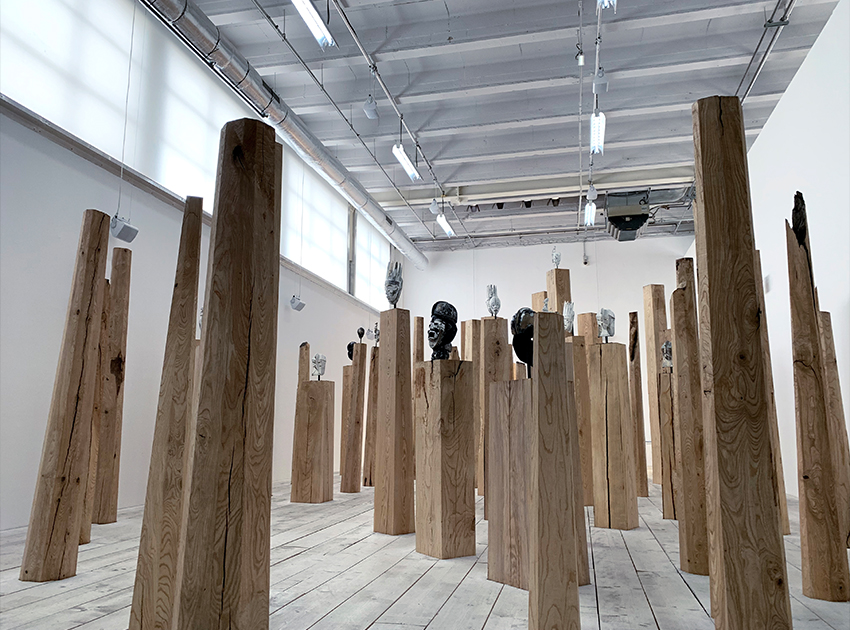
View of the exhibition “Amalgam” by Theaster Gates, Palais de Tokyo, 2019 / Photo © Courtesy of André Morin and Palais de Tokyo
PALAIS DE TOKYO X THEASTER GATES
After a joyful conversation with a curator friend over lunch at Monsieur Bleu of Palais de Tokyo, we went to see the powerful installation “Amalgam” of Theaster Gates.
The new season at Palais de Tokyo “Sensible” opened with uncertain motions. Being “sensible” means changing on contact with others, putting into relation the world’s imaginaries, while producing the unforeseen futures of our mingled destinies. It is with just such unstable matter that the artists presented in this season work; Theaster Gates, Angelica Mesiti, Julien Creuzet, Louis-Cyprien Rials, Julius von Bismarck and Franck Scurti, paying particular attention to movements: in social history, migrations, cultural heritages.
In an astonishingly short space of time, Theaster Gates has incubated compelling new models for legacy building, social transformation, and making art. Gates is an American social practice installation artist whose work includes sculpture, installation, performance and urban interventions that aim to bridge the gap between art and life. He works as an artist, curator, urbanist and facilitator and his projects attempt to instigate the creation of cultural communities, creating hubs and archives for black culture by acting as catalysts for social engagement that leads to political and spatial change.
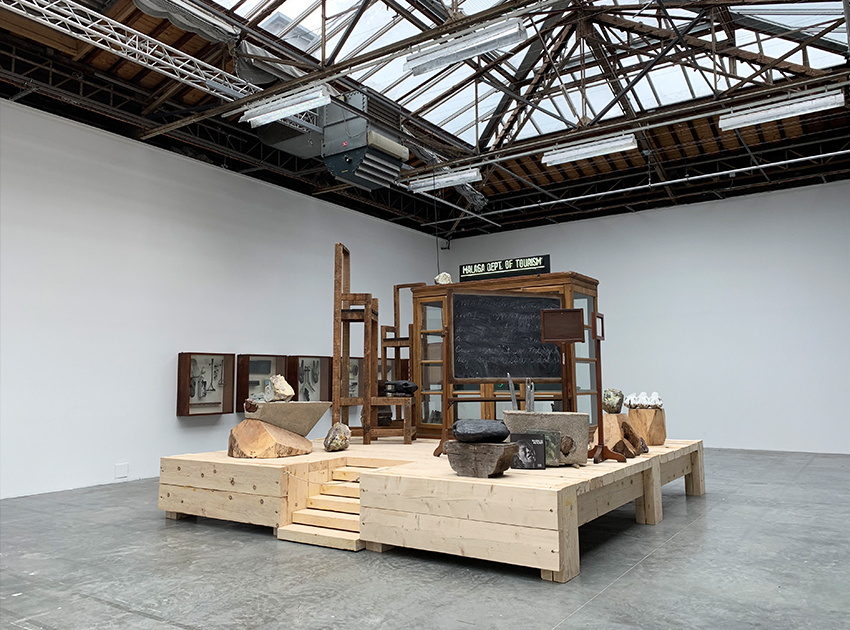
View of the exhibition “Amalgam” by Theaster Gates, Palais de Tokyo / Photo © Courtesy of ZOLTAN+
Encompassing sculpture, painting, installation, video, performance, and music that aim to bridge the gap between art and life, his installations and sculptures mostly incorporate found materials, often from the neighbourhoods where he is engaged and has historical and iconic significance. Other sculptures derive from the stage set for performances. Made from recycled planks of wood, these over-sized, throne-like chairs emphasise the role of server and served and appear as both scaffold and monument.
For his first solo museum exhibition in France, Gates has initiated an entirely new project that explores social histories of migration and interracial relations using a specific episode in American history as his point of departure to address larger questions of black subjugation and the imperial sexual domination and racial mixing that resulted from it.
The starting point of the exhibition, entitled “Amalgam” – in technical terms used in the past to denote racial, ethnic and religious mingling – is the story of Malaga Island in the state of Maine, USA. In 1912, the state governor expelled from Malaga the poorest population, an interracial, mixed community considered “indolent” by many of the local white inhabitants. These unfortunate people were forced to relocate throughout the mainland; some were even involuntarily committed to psychiatric institutions.
For Gates, it has acquired an even more charged significance, impelling his practice towards new formal and conceptual explorations in sculpture, architecture, and music. Currently, he is Distinguished Visiting Artist and Director of Artist Initiatives at the Lunder Institute for American Art, Maine, USA.
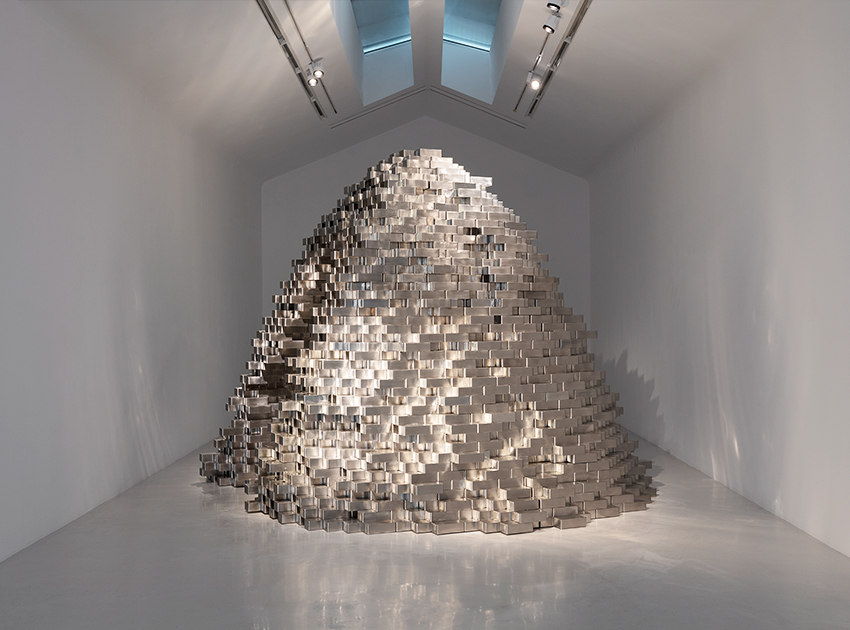
View of the exhibition “Oracles” by Jean-Michel Othoniel, Galerie Perrotin / Photo © Courtesy of Claire Dorn and Galerie Perrotin
PERROTIN X JEAN-MICHEL OTHONIEL
If you are looking for the fast trip to Korea via the Japanese archipelago or to Agora and back in one day, the Galerie Perrotin offers a magic journey through his artists highlighting the works of Jean-Michel Othoniel, Otani Workshop and Kim Chong-Hak.
The journey begins with 82-year-old Korean artist Kim Chong-Hak on the ground floor, continues upstairs with Japanese artist Otani Workshop presenting “Tales of Awaji “ his ceramics made of Shigaraki clay, and the floor below with Jean-Michel Othoniel’s latest work “Oracles”, a set of sculptures made out of coloured glass and metal bricks.
“The brick served them as stone and the bitumen served them as mortar. And they said, go, let us build a city and a tower, whose top may reach heaven.” From Genesis to Herodotus, the Father of History, between history and myth, the Tower of Babel and its destruction have fired the imagination.
What remained of the symbolic link between heaven and earth? What happened to the bricks used to erect it? The questions are raised and they underlie Othoniel’s “Oracles” presented for the first time at Galerie Perrotin.
Othoniel brought 15 minimalistic, enigmatic sculptures together made of glass and metal bricks. He has systematized the use of a module after a journey to India in 2009. On the road from Delhi to Firozabad, a city with an age-old glassmaking tradition, he was struck by stacks of bricks accumulated in the hope of building a house and by countless altars covered in offerings and multicoloured necklaces. He was then called on the knowledge of Indian glassblowers to create bricks in blue, amber, yellow and grey colours and the glass bricks have eventually led Othoniel towards more refined and radical works between sculpture and architecture.
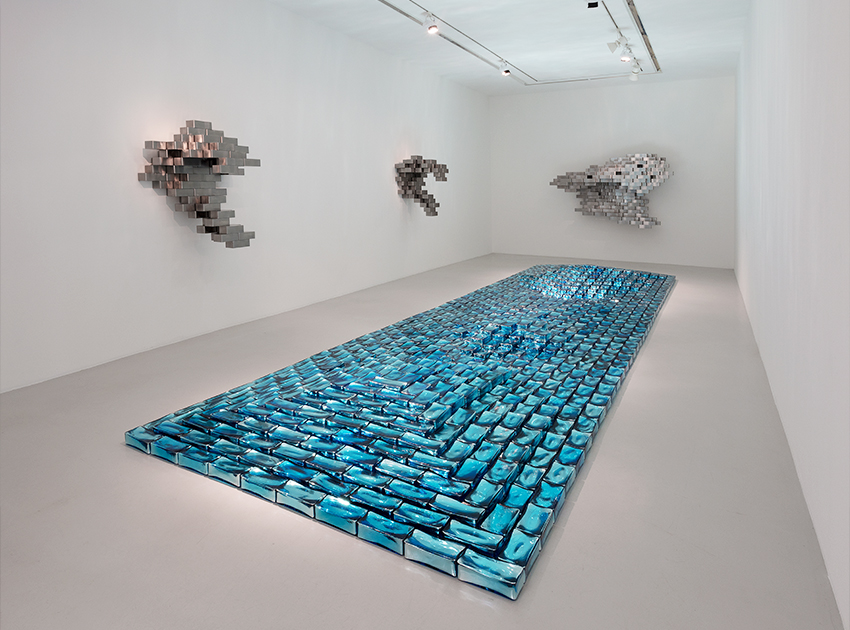
View of the exhibition “Oracles” by Jean-Michel Othoniel, Galerie Perrotin / Photo © Courtesy of Claire Dorn and Galerie Perrotin
For the exhibition, Othoniel has chosen to concentrate exclusively on glass and stainless steel through abstract, monochrome propositions and in brick, he has found a universal element, a common denominator between cultures and one that has traversed the history of humanity. The bricks enabled him to reach the architectural scale, to go beyond the idea of sculpture, to invent a new relation to space, to rethink his relation to geometry and landscape. Consisting of mirror-like, futuristic stainless-steel bricks, “Agora” is the synthesis of the ideas brought by the exhibition expressing the artist’s desire to move increasingly towards architecture.
“For a long time, I have wanted to build Agora, a space where free speech would be protected by the status of the artwork.” Jean-Michel Othoniel
Between sculpture and architecture, the monumental and the intimate, “Agora” emanates a poetic and sensual power.
CENTRE GEORGES POMPIDOU / Place Georges-Pompidou, 75004 Paris, France
“Vasarely.Sharing Forms” Victor Vasarely Retrospective / 6 February 2019 – 6 May 2019
PALAIS BRONGNIART / Place de la Bourse, 75002 Paris, France
““Shared Roots” by Vik Muniz / 16 March 2019
MAISON RUINART / Reims, France
PALAIS DE TOKYO / 13 Avenue du Président Wilson, 75116 Paris, France
“Amalgam” by Theaster Gates / 20 February 2019 – 12 May 2019
GALERIE PERROTIN / 76 rue de Turenne, 75003 Paris, France
“Oracles” by Jean-Michel Othoniel / 16 March 2019 – 8 June 2019
TOP PHOTO: Installation by Theaster Gates at Palais de Tokyo, Paris / Photo © Courtesy of ZOLTAN+
Text and photos by courtesy of Zoltan Alexander © ZOLTAN+ London © ArtLyst

